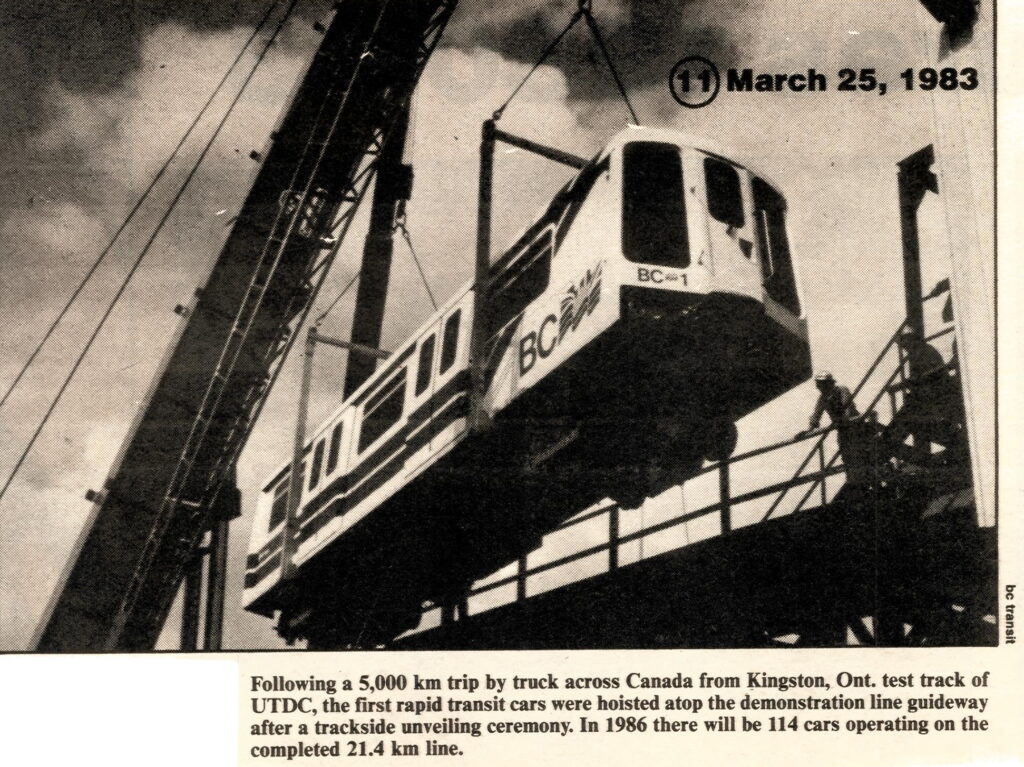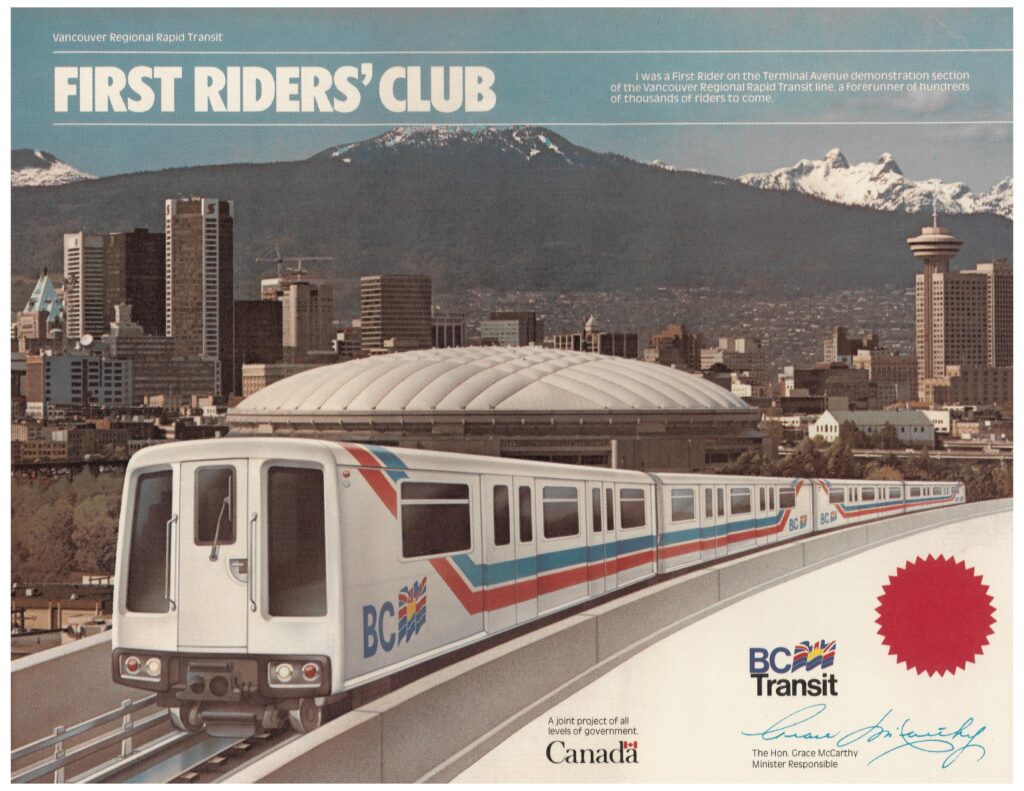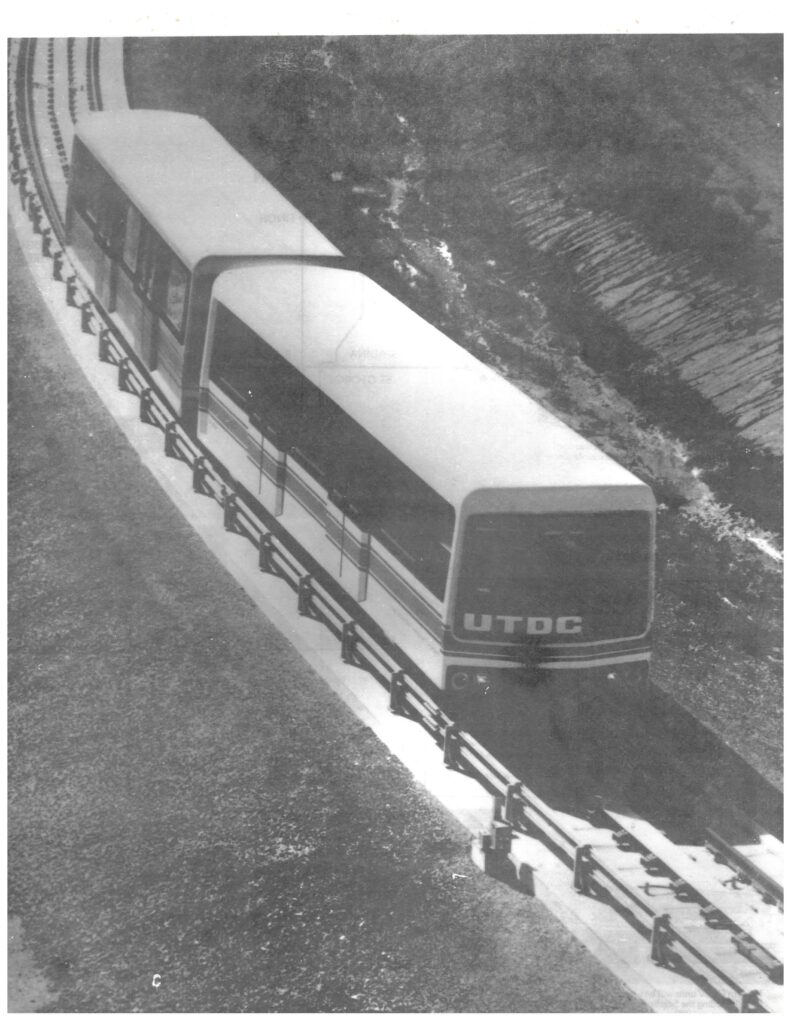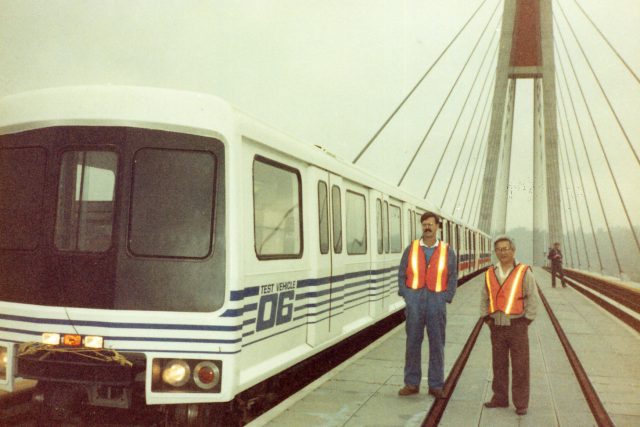While cataloguing some newspaper clippings, we came across these two. Being dated 1983 they are likely from the in-house newsletter Commuta. (In case you missed the clever use of the portmanteau pun, the transit authority at the time was the Urban Transit Authority or UTA. But despite the creative title, it was soon retitled Commuter when BC Transit took over the Authority.)


Both cars operated on a demonstration track the length of Terminal Avenue. Vancourites lined up for the opportunity to have a ride on this roughly 1 km long track.

(For the record, BC1 and BC2 were shipped back to Kingston, where conventional wisdom is that they were modified to the production standard Mark 1 SkyTrain cars . They then returned to Vancouver. ) So one would be tempted to call these test vehicles — but no! They were pre-production prototypes. The real test vehicles led a sheltered life, unseen for the most part by commuters.
The TV fleet
Documentation is scare, but it appears from available descriptions that the first test vehicle was probably no more than a crude “sled” just to evaluate the concept of ICTS (Intermediate Capacity Transit System) and its’ LIM (Linear Induction Motor) power system.
We can see the genesis of the vehicles that would be become “SkyTrain” in this brochure cover. Likely these are TV-2 and TV-3. Now , in 1979, UDTC, the system builder, is moving towards full computer control.

Not much is known about TV-4, other than it is listed as a BC Transit demonstration build. TV-5 was essentially a standard Mark 1 modified for multiplex control. The Mark 1s in Vancouver had discrete wiring for all controls. Much like modern buses, UTDC prototyped the use of multiplex control, reducing the wiring by up to 50-60%. This vehicle wore BC Transit red and blue stripes, but there is speculation this was for publicity purposes. It was never used in service though it spent three months in Vancouver. TV-5 has been saved from the scrapyard and is housed at the Canada Science & Technology Museum in Ottawa, which supplied the below photo.

On the museum website is the following description of the vehicle:
The Innovia ART 100 is an aluminium prototype rapid transit rail car. It was built in 1982 as a pre-build demo for Vancouver’s Expo Line or Intermediate Capacity Transit System (ICTS), later referred to as Advanced Light Rapid Transit (ALRT) or Advanced Rapid Transit (ART). It is one of the first prototypes built for use with the rapid transit version of the Automatic Train Control (ATC) System. The ATC System uses a computer program to automate transit networks, thus allowing for “driverless” operation of rail cars. The Expo Line, or Sky Train, was launched in 1986 and was the world’s first fully automated driverless system that used steel wheels on a steel rail. The first fleet had 114 UTDC Innovia ART 100s but later increased to 150 vehicles. The line ran for 49 km (30 miles) and had 11 stations. In conjunction with the Vancouver line, UTDC also employed ICTS for Detroit’s downtown people mover system and for the Toronto Transit Commission’s (TTC) subway system. However, the Vancouver project was the largest. The Innovia ART 100 was made and tested in Kingston, Ontario with a three month testing period in Vancouver. Afterwards, it was taken to the Bombardier testing facilities in Millhaven, Ontario where it was used as a general testing car. It was relabeled Test Car # 5 at this time.
This would appear to indicate that at least one of the two pre-build prototypes (BC1 and BC2) were not modified and sent back to Vancouver. It became TV-5. But I must point out that the citation appears to incorrectly identify the vehicle as Innovia ART 100. This is misleading, at the time it was built the Innovia branding was a product of Westinghouse, not UTDC.
Though the ICTS system was designed as a lower cost intermediate capacity transit system, there soon became a desire to increase its capacity. The standard Mark 1 capacity was 40 seated and 80 standing. UDTC produced a widenned car nicknamed “Fat Albert”, in the early 1990s. (“Fat Albert” was a cartoon character invented by comedian Bill Cosby.) The car could carry 50 seated and 90 standing passengers. “Fat Albert” was soon overtaken by development of the longer Mark 2 trainsets. Their increased capacity was realized by longer length (68 seated, 110 standing) rather than wider width. Had the “Fat Alberts” been produced, guideway and platform realignments would be needed, the Mark 2s seemed to be an more elegant and cheaper solution. The Test Vehicle for their development was probably numbered TV-06. It included a newer design of truck. It is believed that it was created by joining portions of the two pre-build cars BC1 and 2.

(This picture of “Fat Albert” is courtesy Bob Webster. It was taken in November 1993)

(TV-06 on test on the Sky Bridge. Courtesy TransLink)
